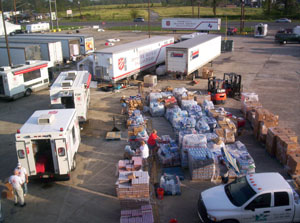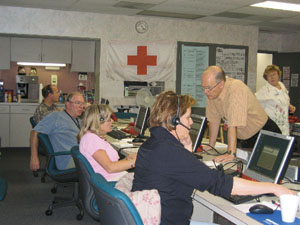Relief Agencies Not Surprised by Kansas City's Response
by David Smale
 Salvation Army volunteers load up supplies for New Orleans evacuees.
Salvation Army volunteers load up supplies for New Orleans evacuees. Of course, there were plenty of other cash gifts that were disclosed through the KC Katrina Relief effort. Large companies like Sprint, Time Warner and Capitol Federal Savings made sizeable donations and/or matched their employees’ donations. The Greater Kansas City Community
Foundation set up two relief funds, one to support displaced families and the other to help rebuild the New Orleans area.
North Kansas City Hospital donated $20,000. The cities of Olathe, Kan., and Parkville, Mo., adopted cities in the ravaged area to match needs with resources in order to provide financial support, food, clothing and other critical supplies. The list goes on.
Alexander believes that Kansas City, and the Midwest in general, is generous because of “our agrarian history. We come from a ‘let’s roll up our sleeves and get it done’ type of community. Kansas City is not that old, really, and we’ve always just had to do it ourselves. We’re not going to wait for one of the coasts to come in and tell us how to get it done. We just see our neighbor in need and help them.”
Bartkoski agrees that Kansas City is generous, though she points out that nearly every city in the country has joined the effort. She notes that 190,000 volunteers from all 50 states traveled to the Gulf Coast region to help in the clean-up. She also has a theory why KC is always so responsive.
“There was a crew of utility workers who went down because there had been a crew from one of the affected areas who had come to help in Kansas City following the ice storm a few years ago,” she said. “People remember all the people who came here to help us when we had a disaster. There is that sense of wanting to give back.”
 The National Response Call Center, established in the Greater Kansas City Chapter on September 9, has taken more than 32,000 calls from individuals in the storm-affected areas of Louisiana, Mississippi, Florida, Alabama and Texas, as well as other parts of the country. This Center is manned by more than 190 volunteers.
The National Response Call Center, established in the Greater Kansas City Chapter on September 9, has taken more than 32,000 calls from individuals in the storm-affected areas of Louisiana, Mississippi, Florida, Alabama and Texas, as well as other parts of the country. This Center is manned by more than 190 volunteers. The American Red Cross works with other organizations because one organization cannot do it all alone. “We have been working in conjunction with the Salvation Army and other organizations providing the type of service they can provide,” she said. “One organization cannot do everything. By working together, it provides a much stronger net for those affected by something like the hurricanes.
“Working with partners and different organizations, together we can provide more services, each one handling its own niche, rather than duplicating efforts.”
Part of each organization’s niche is how it distributes the money raised. The Salvation Army has used some of the money it received to provide more than 9 million meals, both to residents in the Gulf and relocated families across this area. Besides direct aid to the victims, Alexander points out that there are costs to providing mass aid.
“We have between 100 and 150 mobile feeding units,” he said. “Those units require fuel. The generators that provide electricity wear out and need to be replaced. We have housing costs for the 6,000 staff and volunteers across the Gulf Coast area. Some remain in now.
“Getting people and supplies down there and back is an expense. Kansas City Southern Railroad offered to ship things down there. Many of the trucking companies were very generous in allowing the shipping of goods at no expense, for which we are very grateful. Now, they need to recover some of their gas expense. We have to pay fuel costs to get shipments down there, but that’s still a lot cheaper than it should be.”
Alexander also mentioned a donation of 15,000 T-shirts for volunteers and staff to wear during the relief effort. That company also donated hats. The Salvation Army also received donations of sunscreen and sunglasses. “It’s hotter than all get-out down there,” he said. “Donations don’t have to be real technical.”